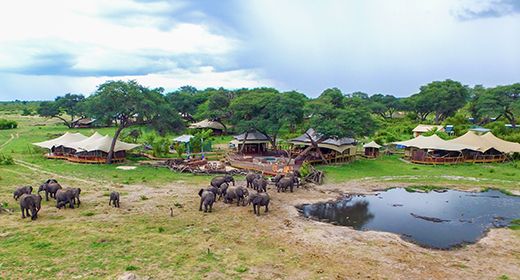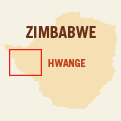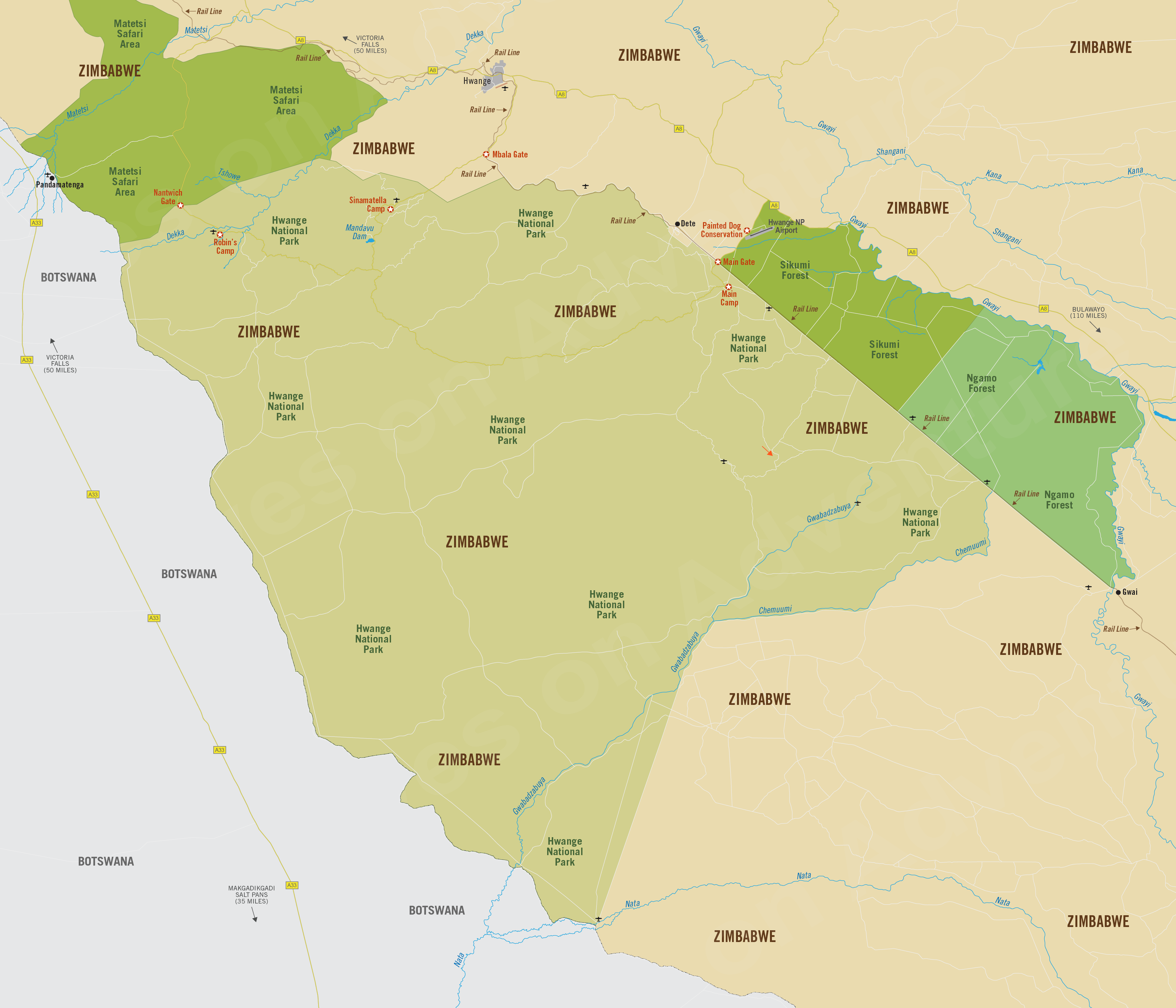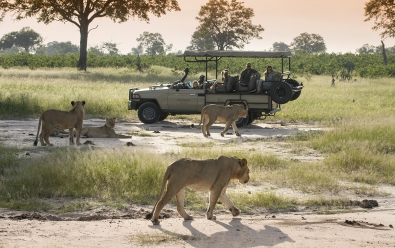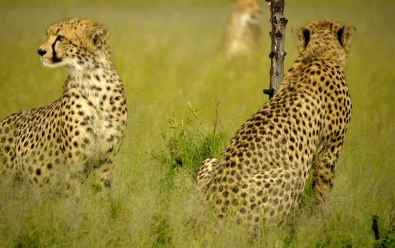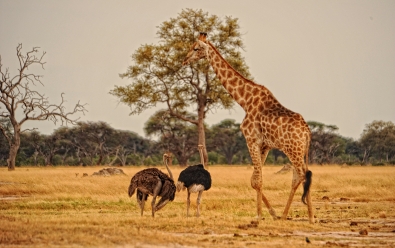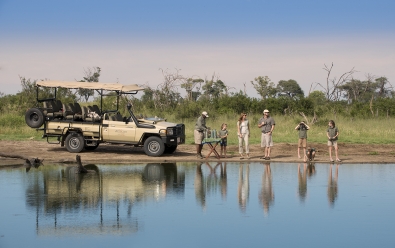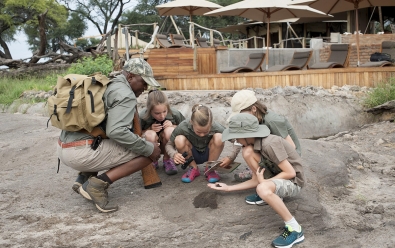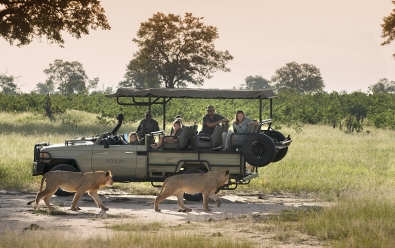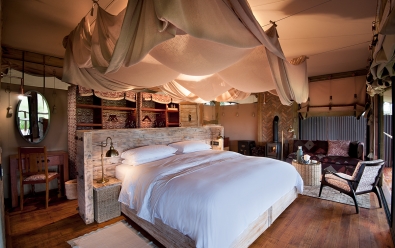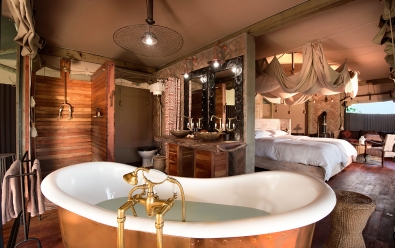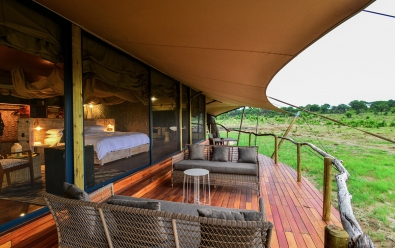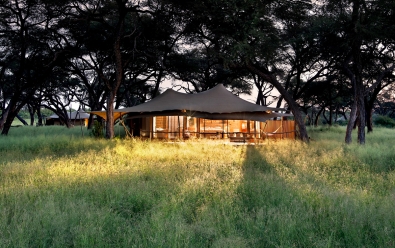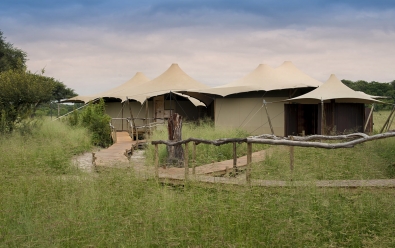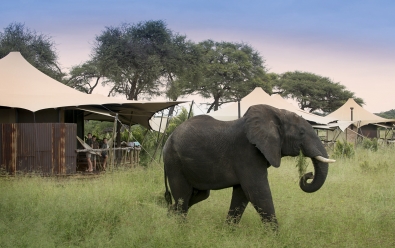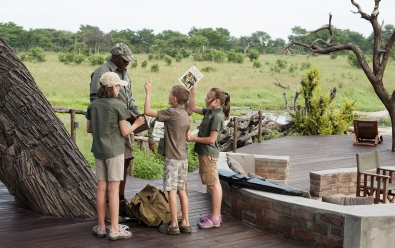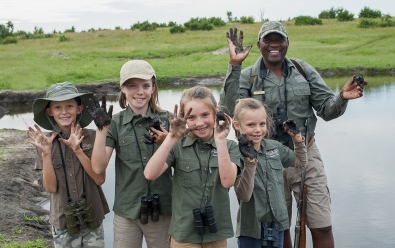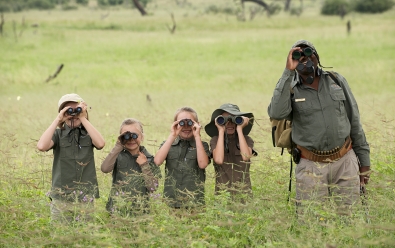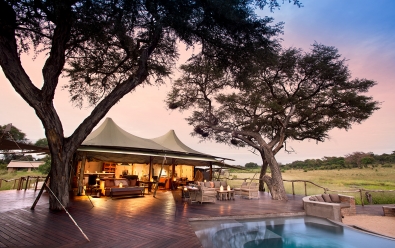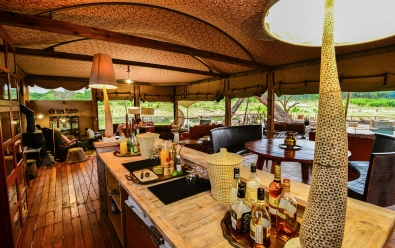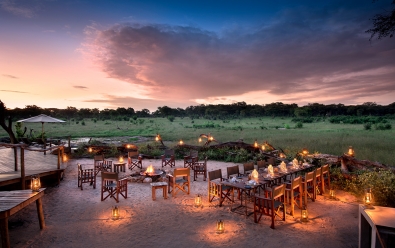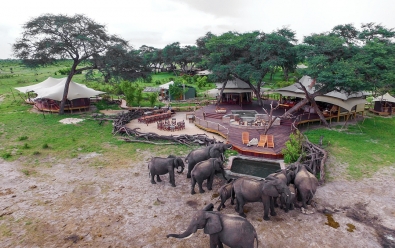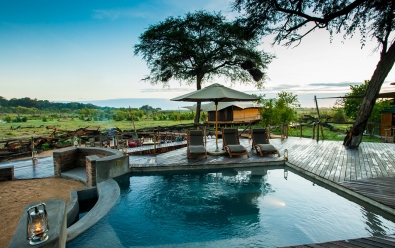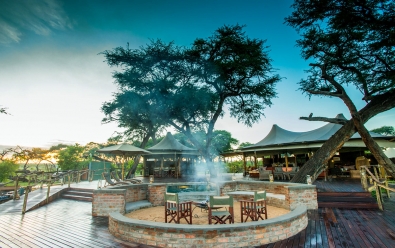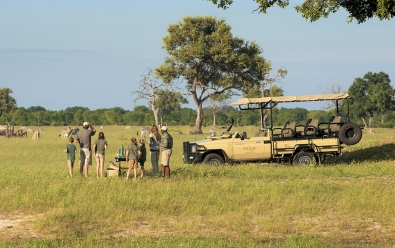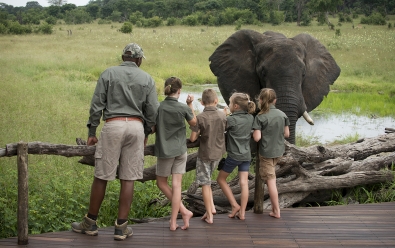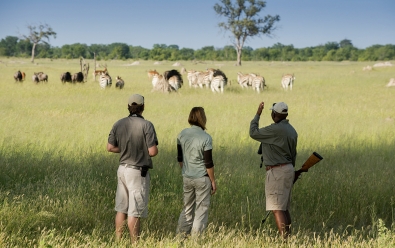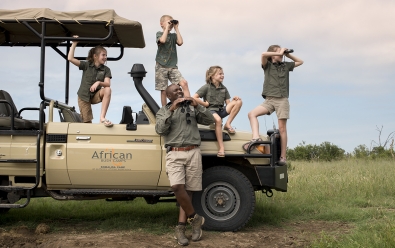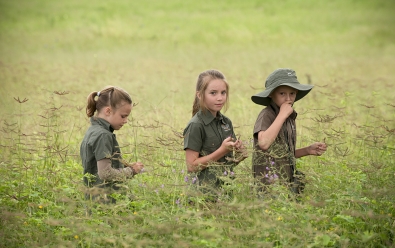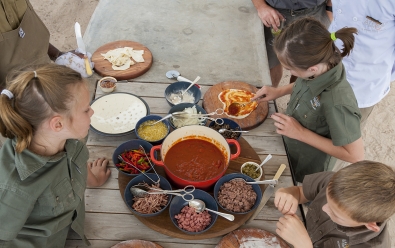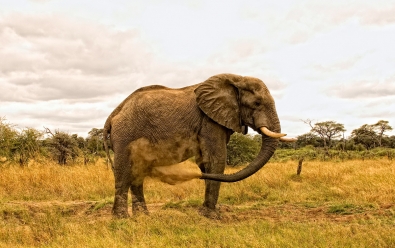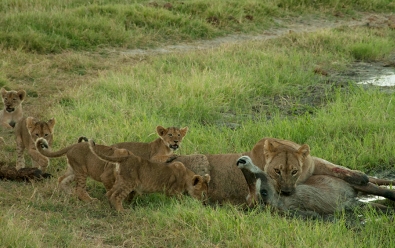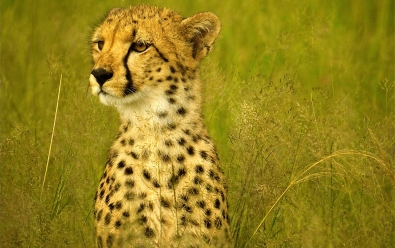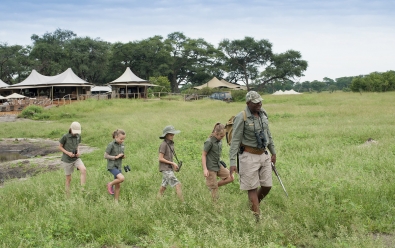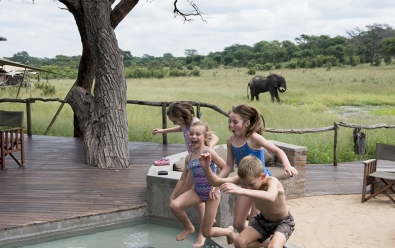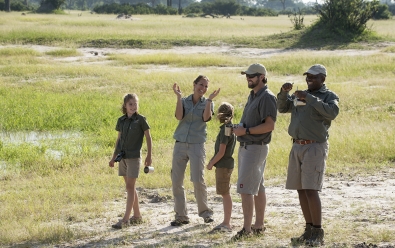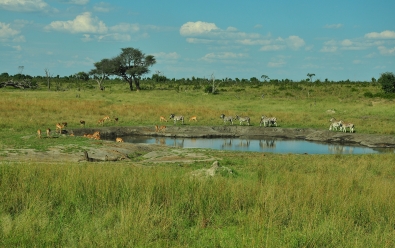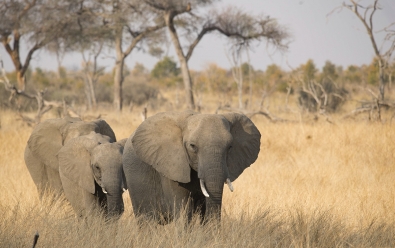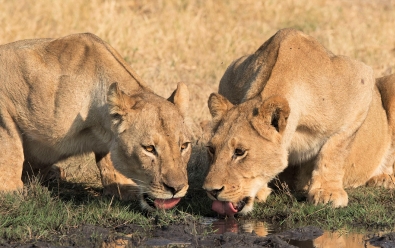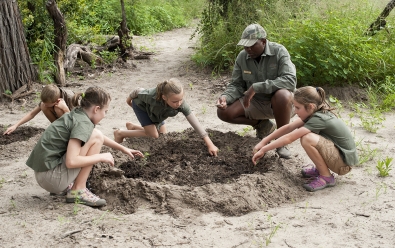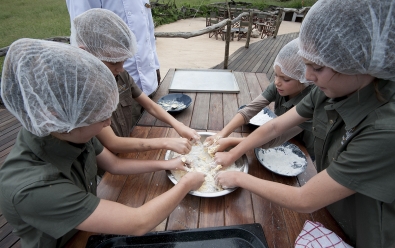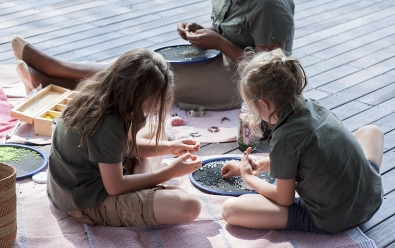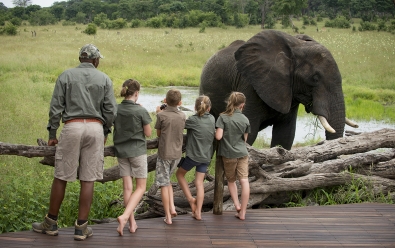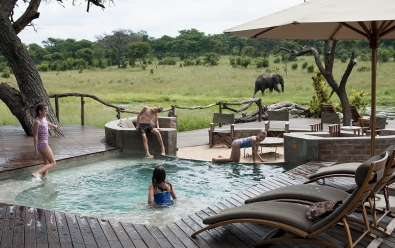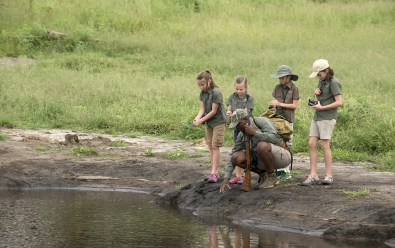Somalisa Acacia Camp
Highlights
- Family-oriented, eco-friendly, upscale, safari camp.
- Game drives, bush walks, sleep-out hide, cultural visits.
- Diverse wildlife; especially good for elephants and predators.
- Located in one of the park's best wildlife areas.
Location
- Hwange National Park
- Western Zimbabwe
Somalisa Acacia is a small, upscale, family-oriented, tented camp located within a private concession of historic Hwange National Park.
Somalisa Acacia Camp, along with its two sister camps, Somalisa Main Camp and Somalisa Expeditions, is located in the wildlife-rich, eastern section of the national park, where game viewing is very rewarding, particularly during the long, dry season from June into November.
The area around the camps is especially good for seeing elephants, which are seen regularly on game drives, but also throughout the midday hours as they visit the watering hole in front of the camp.
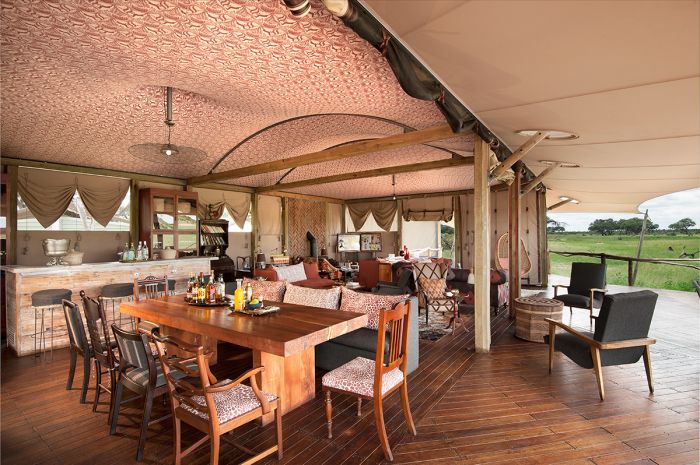
Main area dining and lounge space at Somalisa Acacia.
Activities at Somalisa Acacia include twice-daily (or full-day) game drives in customized, open Land Cruisers, walking with an armed guide, sleep-outs at the Somalisa overnight platform overlooking a popular wildlife waterhole, and cultural visits to a local village.
Wildlife in this far southeastern part of Hwange is abundant and diverse, with the stars of the show being Hwange's elephants. Other commonly seen herbivores include zebra, giraffe, buffalo, impala, blue wildebeest, sable, waterbuck, roan, and warthog. Hippos are found in some of the park's waterholes.
Commonly encountered predators include lion, leopard, spotted hyena, African wild dog, and black-backed jackal. Cheetah are sometimes seen. Crocodiles are found in some of the waterholes. Birding in the park is excellent, with over 400 species recorded. Wildlife viewing is best during the dry winter months, when the waterholes become very busy with animals coming to drink.
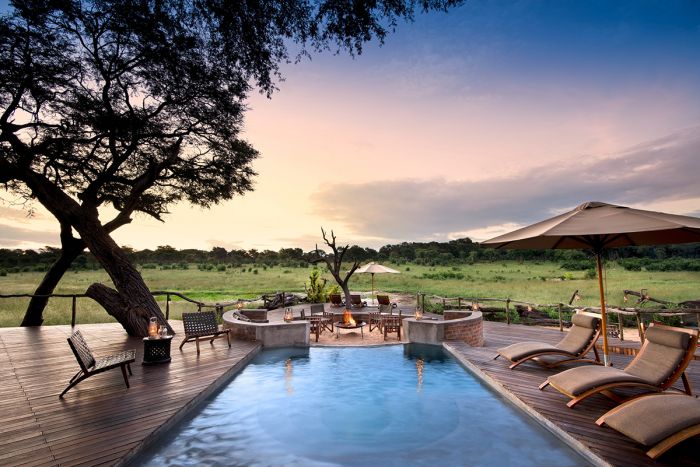
Main area pool, campfire, and viewing deck at Somalisa Acacia.
The camp offers four luxurious, canvas-and-wood, safari suites, two of which are 2-bedroom units that are ideal for families. The spacious tents offer comfortable beds (twin or double setup), an outdoor deck overlooking the active waterhole, and fully-plumbed facilities with both indoor and outdoor showers, bathtub, double-basin vanity, and flush toilet.
The main guest area is built on an elevated wooden deck and features a wood-and-canvas structure that includes a comfortable lounge, dining area, bar, and coffee/tea station. The lounge and dining areas open into the front viewing deck with lounge seating and a campfire area, both of which afford excellent views over the camp's waterhole for watching wildlife.
The far edge of the deck has a deep, freshwater pool that is designed to offer guests incredible, up-close views of elephants, which come frequently to drink. The deck also incorporates a relaxing plunge pool and sun deck that offers a great way to spend some of the midday hours between safari activities. A protected 'boma' is located alongside the deck at ground-level and is often used for dinners under the stars or just for evening drinks around the campfire.
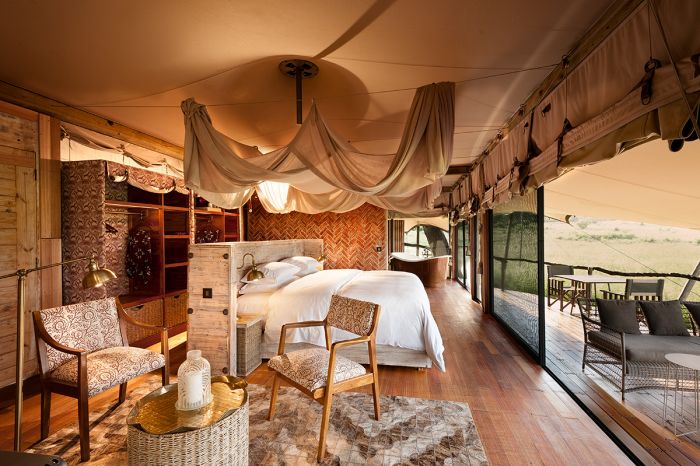
Guest suite interior at Somalisa Acacia Camp.
Somalisa Acacia is an eco-friendly safari accommodation and was awarded the first Gold-level 'Green Tourism Certification' in Zimbabwe. The camp operates primarily on solar energy, but a generator provides a backup power source and there is 24-hour electricity in the guest tents and the main area.
The Somalisa camps are owned and operated by African Bush Camps (ABC), a company founded by a professional African safari guide, who has a passion for protecting remote spaces and the wildlife that lives there.
African Bush Camps operates safari camps in Botswana, Zimbabwe, and Zambia. The ABC camps are fully sustainable, with minimal impact on the environment. The African Bush Camps Foundation runs local projects that empower the local communities wherever they operate safari camps. The company's aim is to conserve and preserve wildlife and natural areas in Southern Africa.
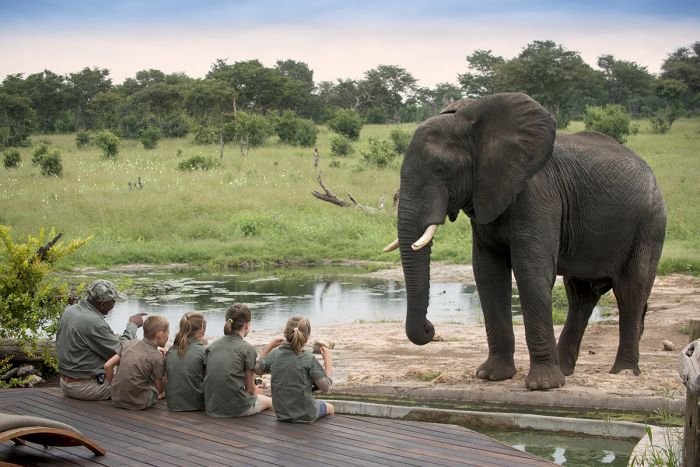
Watching an elephant up close on the deck at Somalisa Acacia Camp.
About Hwange National Park
Hwange is located in western Zimbabwe bordering Botswana and is the country's largest national park. Hwange's history as a protected wildlife area dates back to 1928, when the British Colonial administration declared it as the Wankie Game Reserve, making it one of the oldest formal reserves in Africa. The name of the park comes from a local Ndebele chief named Hwange Rosumbani, but it was anglicized by the white settlers into 'Wankie'.
Although Hwange is bounded on the north and south by rivers, the vast interior of the park is a naturally dry and waterless region. In the early years of the reserve, wildlife only visited in good numbers during the rainy season (November to April), after which most of the animals moved away from the area due to the water shortage in the reserve.
The park's first warden was a man named Ted Davison, who decided that in order to make the reserve a place people would want to come, the park needed water sources. In 1939, Davison and a team of workers began work on what would later become over 50 boreholes, which were pumped by windmills and supported by diesel pumps. The pumped water was directed into either a natural pan or one which the workers created.
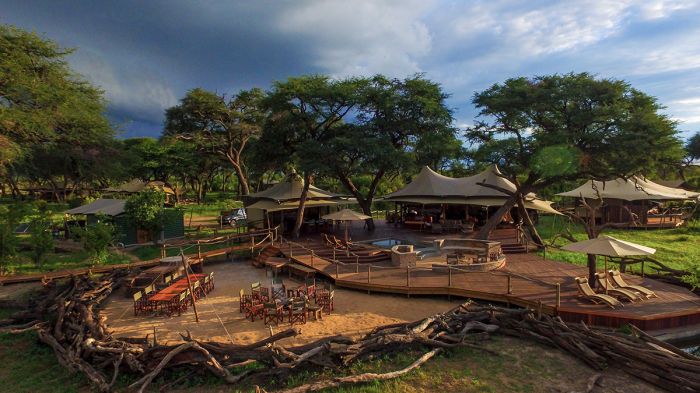
Main area at Somalisa Acacia, showing the boma, pool, viewing deck, and dining / lounge areas.
Davison's waterholes were eventually spread out across the park's dry interior and a road network was soon developed to connect many of these pans. After some years with the waterholes operational, wildlife started to stay in Hwange all year. These waterholes are still the life blood of the park's tourism industry today.
The most productive wildlife areas in Hwange are in the north and east, with the central and southwest portions characterized by Kalahari sands with sparse vegetation. As such, all of the safari camps in Hwange are located along the north and east perimeters of the park.
Bordering Hwange on the east are two mixed-use areas that are mainly used for commercial hunting. Bordering the park in the northwest is another hunting area called Matetsi.
Wildlife viewing in the north and east of the park is excellent, particularly during the dry season and around Hwange's network of pumped waterholes. The park is especially well known for its elephants, with large groups consisting of multiple herds often seen together drinking at a waterhole.
Besides the abundant elephants, commonly seen herbivores in Hwange include buffalo, giraffe, zebra, blue wildebeest, greater kudu, impala, roan, sable, reedbuck, waterbuck, tsessebe, red hartebeest, steenbok, and warthog.
Hwange is also a superb place to see predators, with healthy populations of lion, leopard, spotted hyena, African wild dog, and black-backed jackal. Cheetah are found in Hwange in smaller numbers.
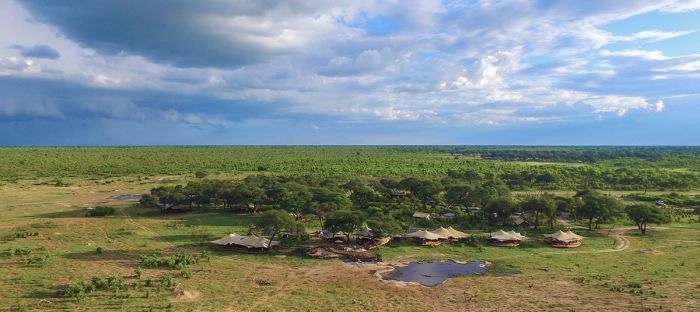
Aerial view of Somalisa Acacia Camp.
Hwange's rhinos (both black and white species) were poached to extinction during the 1980s, but a small number of black rhinos were reintroduced and are under continuous monitoring. Some of Hwange's waterholes are home to hippos and crocodiles. Birding in the park is superb, with over 400 species recorded.
The Painted Dog Conservation Centre, located just outside the Main Gate, works to conserve the endangered African wild dogs in the greater Hwange region. The project employs over 60 people from local villages to run the centre's programs, which include research, conservation, education, and anti-poaching. The facility is open to the public every day.
ROOMS INCLUDES & EXCLUDES CHILDREN FACILITIES ACTIVITIES
Accommodation
4 guest accommodations in total comprising:
- 2 wood-and-canvas, luxury tented-suites, each with two three-quarter beds and an outdoor deck with lounge seating. The beds can be converted to a double bed on request.
- 2 two-bedroom, wood-and-canvas, luxury tented-suites. The main bedroom has two three-quarter beds that can be converted to a double bed on request and the second bedroom, which is perfect for children, has two twin beds. Each bedroom has its own fully-plumbed facilities, including an indoor shower, luxurious bathtub, double-basin vanity, and flush toilet. The master bedroom also has an outdoor shower. The bedrooms share an inter-leading entrance/foyer and an outdoor lounge-deck.
All the guest suites feature fully-plumbed, en-suite facilities that include an indoor shower, outdoor shower, copper-encased, slipper-style bathtub, double-basin vanity, and a flush toilet.
The guest suites are constructed atop slightly-elevated, wooden platforms with sand footpaths leading to the main camp area.
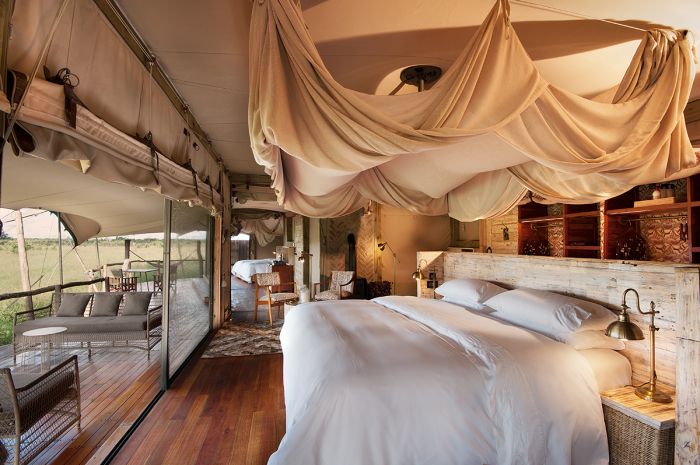
One of two 2-bedroom, family suites at Somalisa Acacia Camp.
Other items and features in the guest suites include:
- Mosquito netting over the beds.
- Wood-burning fireplace.
- Pedestal fan.
- Writing desk and chair.
- Outdoor veranda/deck with table, deck chairs, day-lounger, and hammock.
- Butler's hatch for room service items like morning coffee and tea.
- Coffee / tea station.
- Safe for storing valuables.
- Multi-plug charging station.
- Personal amenities, including laundry basket, robe and slippers, liquid soap, body wash, shampoo and conditioner, insect repellent, insect spray, room spray, vanity kit with cotton-tip swabs and cotton wool pads, shower cap, and umbrella.
Somalisa Acacia Camp can accommodate a maximum of 12 guests in total: 2 guests in each of the 2 standard tents and 4 guests in each of the 2 family tents.
Includes & Excludes
Includes:
- All meals and local beverages including wines, spirits and liqueurs, but excluding premium imported brands and Champagne.
- Twice-daily safari activities including game drives in open game-viewing vehicles, nature walks, and other scheduled camp activities (all accompanied by experienced guides).
- Laundry services are provided on a daily basis (weather permitting, items will be returned on the same day). Laundry is dried by the sun and on most days any laundry placed out in the morning will be returned by the evening.
- Manga airstrip road transfers.
- Tourism Levy & VAT.
Excludes:
- Premium imported beverages and Champagne.
- Cultural tour of a local village.
- Any applicable wildlife fee, park fee, reserve fee, concession fee, other land-use fee.
Single Supplement
A single supplement will apply for any room booked by a single traveler; please ask us for pricing.
Children
Children of any age are accommodated at Somalisa Acacia Camp.
- Families are encouraged to stay in one of the 2-bedroom family tents.
- Children under 16 years of age are charged a child rate and must share with an adult/s in the same suite (if a standard tent) or stay in one of the family tents.
- Children aged 16 years and older will pay applicable adult rates and can be accommodated in a separate tent or sharing with a parent.
- Families with children will be accommodated in the same vehicle as other guests for game drives. Private vehicles are an option (subject to availability and at additional cost).
- Walking activities are available to guests aged 16 years and above.
- Ngwana Club is a family-friendly program that offers kids of all ages a variety of safari-related activities.
- Young children must be supervised by their parents, as the camp is not fenced and is located in an area with wild animals.
Facilities
Somalisa Acacia Camp is located alongside its sister camp, Somalisa Main Camp within a private concession in the eastern side of Hwange National Park. The area is one of the prime wildlife areas in the park and is particularly good for elephants.
The main camp area consists of two canvas-covered structures supported by wooden beams and constructed atop an expansive, elevated wooden deck. The main indoor space opens onto the large, outdoor viewing deck (with roll-down, protective flaps in case of wind or rain) and comprises a lounge with comfortable seating, an indoor dining area, a bar, and a coffee/tea station.
The main area's viewing deck features several comfortable seating areas, including a sunken campfire area for evening drinks and discussion, and a refreshing swimming pool and sundeck with loungers. The deck leads down to a protected, ground-level 'boma', which is used for al fresco dining.
The front of the deck also incorporates an 'elephant pool', which is filled with fresh water for the area's elephants to come and drink, allowing guests on the deck to safely observe them up close.
The well-stocked Safari Shop (located at Main Camp) offers African curios and other items for sale. Behind the main area is the camp's solar-power system, featuring an array of solar panels that provide electricity to the camp. The camp also utilizes a fresh-water purification system that helps facilitates an 80% recycle rate for the camp's water usage.
Main guest area facilities include:
- Semi-open, lounge, dining, and bar area under canvas on a raised wooden deck.
- Outdoor viewing deck with lounge seating and a campfire area.
- Pool and sundeck.
- Outdoor boma for dining under the stars.
- The 'elephant pool' for up-close viewing as they come to drink.
- Guest toilet in the main area.
- Safari shop with items for purchase (located closely at Main Camp).
Activities
Activities included in the rate:
- Day and night game drives in 4x4 Land Cruisers.
- Game drives traverse the private Somalisa Concession, as well as some adjacent areas of the national park.
- Birding.
- Guided nature walks.
Optional activities at additional cost:
- Private activities are on offer (subject to vehicle availability, which needs to be booked in advance).
- Sleep-outs at the Somalisa Sleep-out Platform overlooking Ray's Pan, a very popular watering location for wildlife. Maximum 2 guests; children must be at least 7 years of age. Requires a minimum 3-night stay at any of the Somalisa camps, as well as hire of a private vehicle for the entirety of the stay. Available to be booked from August thru November.
- Cultural tour of a nearby local village.
Example of a typical day:
- Early morning wake-up call. Morning wake-up and activity times vary according to the seasons, activities on offer, and wildlife sightings.
- Light breakfast before departing on the morning activity.
- Return to camp for a meal and rest period.
- Meet for afternoon tea and snacks (savory and sweet choices) before departing on the activity.
- Return to camp - freshen up or meet for drinks, followed by dinner.
- Enjoy a nightcap or discussion around the fire before retiring.
Great Good Fair Poor
- Jan
- Feb
- Mar
- Apr
- May
- Jun
- Jul
- Aug
- Sep
- Oct
- Nov
- Dec
When to Visit
Hwange National Park experiences rainy summers and dry winters like most of Southern Africa and as is usually the case, the dry season coincides with the best wildlife viewing. This is especially true in Hwange, as the park does not have adequate rivers in its vast interior, so the animals depend completely on the series around 60 man-made waterholes that are pumped throughout the dry season to keep the wildlife alive.
The best time to visit Hwange in terms of wildlife viewing in general is from late-May to to late-October or early November.
Somalisa Acacia Camp is open year-round.
Winter / Dry Season
The dry season occurs from May to October and during this time, Hwange typically receives little to no rain. As mentioned, Hwange has no permanent water throughout most of the park, with its rivers only flowing seasonally after substantial local rainfall.
The park's first game warden, Ted Davison, constructed a network of pumped waterholes beginning in the late 1930s, to keep the park's animals from dispersing during the long dry season. These waterholes are still in operation and they are superb for wildlife viewing, particularly during winter.
May is the start of the dry season, but the grass is still lush and the bush verdant after the rainy season, so this is a lively time to visit Hwange. The days are typically clear and daytime temps average 76-82°F (24-28°C), while overnight temps fall to 43-48°F (6-9°C).
June and July are the coldest months of the year and rainfall is extremely unlikely. Most vegetation changes from green to brown and by the end of July, the landscape is quite dry and dusty. The days are clear and sunny, with pleasant temps that average 75-78°F (24-26°C), but the nights are quite chilly, averaging 41-45°F (5-7°C).
August and September are prime months for wildlife viewing in Hwange, with almost non-stop activity throughout the day at the park's pumped waterholes. The landscape is very dry and temperatures are starting to warm, with days averaging 82-90°F (28-32°C) and nights dropping to 50-57°F (10-14°C). In terms of tourist numbers, these months are the busiest.
October is the warmest month of the year in Hwange and there can also be the occasional rain shower during the latter part of the month. Wildlife viewing is superb at the waterholes, with animals coming to drink all day long. The days can be quite hot, with temps reaching 90-98°F (32-37°C) and overnight temps only falling to 62-67°F (17-19°C).
Summer / Rainy Season
The green season in Hwange begins after the first substantial rains, which typically arrive sometime in November. The rains increase in frequency and volume as the days pass. The rainiest months are December thru February, with afternoon showers falling on most days.
The early part of the rainy season in November can be especially beautiful, with the landscape transforming from dry and dusty brown to fresh and green seemingly overnight after the first rains. New life erupts in the form of flowers, grasses, and baby animals, especially the impalas, which time their birthing season to coincide with nutritious new vegetation for the lactating mothers.
Migratory birds are also arriving to breed, adding to park's already abundant bird life. Rain showers occur every other day on average, usually in the afternoons. Temperatures are warm, but moderated somewhat by the rains, with days averaging 88-92°F (31-33°C) and overnight temps of 62-66°F (17-19°C).
December thru February are the wettest months in Hwange and wildlife is able to disperse into the bush and away from the park's network of pumped waterholes. Rain falls almost every day, but it is usually not an all-day event. Temperatures are warm, but the showers keep the feel quite pleasant, with days averaging 82-88°F (28-31°C) and overnights still warm at 64-67°F (18-19°C). The rains can mean muddy driving conditions on the park's non-paved roads.
March sees a decrease in rainfall, but the vegetation in the park is thick after months of good rains. Wildlife is still dispersed away from the waterholes, which negatively impacts game viewing. Temps are still warm, with days averaging 86-89°F (30-32°C) and overnights falling to 58-62°F (14-16°C).
April is the transition month to the beginning of the dry season, with only sporadic showers that typically drop off almost entirely by the end of the month. The park is lush and beautiful and the wildlife is still dispersed far and wide. The weather is lovely, with temps falling somewhat to 82-86°F (28-30°C) during the day and 55-58°F (13-14°C) overnight.




